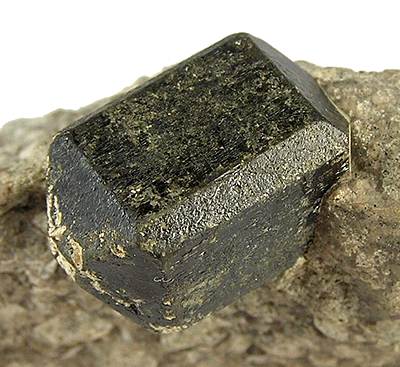Wiluit
| Wiluit | |
|---|---|
| Wiluit crystal in the mother stone of the Wiljui in Siberia, Russia | |
| General and classification | |
| other names |
IMA 1997-026 |
| chemical formula | Ca 19 (Al, Mg, Fe, Ti) 13 B <3 [(O, OH) 10 | (SiO 4 ) 10 | (Si 2 O 7 ) 4 ] |
|
Mineral class (and possibly department) |
Silicates and Germanates |
|
System no. to Strunz and to Dana |
9.BG.35 ( 8th edition : VIII / C.26) 58.02.04.02 |
| Similar minerals | Vesuvianite |
| Crystallographic Data | |
| Crystal system | tetragonal |
| Crystal class ; symbol | ditetragonal-dipyramidal 4 / m 2 / m 2 / m |
| Space group | |
| Lattice parameters | a = 15.716 Å ; c = 11.704 Å |
| Formula units | Z = 2 |
| Physical Properties | |
| Mohs hardness | 6th |
| Density (g / cm 3 ) | 3.36 |
| Cleavage | Please complete |
| colour | dark green, greenish brown, black |
| Line color | colorless, white |
| transparency | transparent to translucent |
| shine | Glass gloss |
| Crystal optics | |
| Refractive indices |
n ω = 1.721 n ε = 1.725 |
| Birefringence | δ = 0.004 |
| Optical character | uniaxial positive |
Wiluit is a rarely occurring mineral from the mineral class of " silicates and germanates ". It crystallizes in the tetragonal crystal system with the chemical composition Ca 19 (Al, Mg, Fe, Ti) 13 B <3 [(O, OH) 10 | (SiO 4 ) 10 | (Si 2 O 7 ) 4 ] and usually forms well developed, tetragonal-dipyramidal crystals of dark green, greenish brown or black color.
Etymology and history
The mineral was first discovered on the Siberian river Wiljui (Russia) and named after this type of locality .
The first descriptions already exist from 1802. In Johann Reinhold Blum's “Textbook of Oryktognosie” from 1833, it is a green garnet and a variant of the Grossular with asparagus, mountain, grass, olive, leek, pistachio green or green-gray described to liver-brown color. Grossular also exists at the type locality, which is why the two minerals have probably been mixed up.
After a new investigation by LA Groat, FC Hawthorne, TS Ercit and JD Grice in 1998, the mineral was recognized by the International Mineralogical Association (IMA) as an independent mineral.
classification
In the meanwhile outdated system of minerals according to Strunz (8th edition) , the Wiluit still belongs to the general department of " group silicates (sorosilicates)", where it forms a separate group together with fluorous vesuvianite , manganese vesuvianite and vesuvianite .
Since the revision of Strunz's mineral systematics in the 9th edition , this section has also been more precisely subdivided according to the type of silicate complexes occurring in the compound and the coordination of the cations involved . The Wiluit is accordingly together with the Vesuvianite group unchanged in the assigned minerals in the new subdivision of “Group silicates with mixed SiO 4 and Si 2 O 7 groups; Cations in octahedral [6] and greater coordination ”.
The systematics of minerals according to Dana , which is common in the English-speaking world , also assigns the Wiluit to the division of group silicates, but there in the sub-division of “group silicates with insular, mixed, single and larger tetrahedral groups and cations in [6] and higher coordination; Single and double groups (n = 1.2) ”, where it also forms its own group, the Vesuvianite group, together with fluorosuvianite, manganese vesuvianite and vesuvianite .
Education and Locations
Wiluit was found together with grossular and serpentine group minerals in serpentinized skarns .
So far, in addition to its Wiljui type locality, the mineral has been found at three other sites (status: 2009): In the Italian region of Ariccia , near Gatineau in Canada, and in the "Bill Waley Mine" in Drum Valley ( Tulare County ) in the USA .
Crystal structure
Wiluit crystallizes isostructurally with Vesuvianite in the tetragonal crystal system in the space group P 4 / nnc with the lattice parameters a = 15.716 Å and c = 11.704 Å as well as two formula units per unit cell .
See also
Individual evidence
- ↑ a b c Webmineral - Wiluite (English)
- ↑ a b American Mineralogist Crystal Structure Database - Wiluite (English, 2005)
- ↑ a b Wiluite at mindat.org (engl.)
- ^ Hugo Strunz, Ernest H. Nickel: Strunz Mineralogical Tables . 9th edition. E. Schweizerbart'sche Verlagbuchhandlung (Nägele and Obermiller), Stuttgart 2001, ISBN 3-510-65188-X , p. 589 .
- ^ Johann Reinhold Blum: Natural history of the three kingdoms - 2nd volume: Textbook of oryctognosia . E. Schweizbart's Verlagshandlung, Stuttgart 1833, p. 222 . ( available online at Google Book Search , last accessed December 9, 2009)
- ↑ Mindat - Localities for Wiluite
- ↑ American Mineralogist Crystal Structure Database - Wiluite (English, 2005)
literature
- Hugo Strunz, Ernest H. Nickel: Strunz Mineralogical Tables . 9th edition. E. Schweizerbart'sche Verlagbuchhandlung (Nägele and Obermiller), Stuttgart 2001, ISBN 3-510-65188-X , p. 589 .
Web links
- Mineral Atlas: Wiluit (Wiki)
